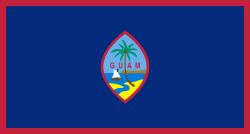Piti (Piti Municipality)
Piti is located along the coastline between the villages of Asan-Maina in the north and Santa Rita in the south. Its inland areas, which include Mount Tenjo (305 m) and Mount Chacao (309 m), borders Yona. Guam Highway 1, known as Marine Corps Drive, runs along the mainland coastline of the village. The Asan Memorial Beach Unit of War in the Pacific National Historical Park is at the northern boundary of Piti and the small hilly peninsula at Asan Invasion Beach is the northern physical marker of the Piti Bomb Holes Marine Preserve. The Preserve off the northeastern coast of the village has two beaches: Tepungan Beach Park and the Pedro Santos Memorial Park. Cabras Island, now artificially connected to the mainland, contains the main power plants for Guam and the Port of Guam and is accessible from the intersection of Marine Corps Drive and Guam Highway 11, known as Cabras Road. The Glass Breakwater that extends westward from Cabras Island protects the northern side of Apra Harbor.
Most of the village population is located uphill of the intersection of Marine Corps Drive and Cabras Road. Jose L.G. Rios Middle School, the Piti Guns Unit of War in the Pacific National Historical Park, Our Lady of the Assumption Catholic Church, and village government buildings are located here. The Guam Veterans Cemetery is located immediately south, at the intersection of Marine Corps Drive and Guam Highway 6, known as Spruance Halsey Drive. Taguag Cemetery is located uphill on Highway 6, which provides southern access to Nimitz Hill, as well as Nimitz Hill Annex in Asan. Immediately south of this intersection is the intersection with Guam Highway 18, which provides access to Drydock Island, a small peninsula extending eastward into Apra Harbor. This provides access to Cabras Marina, military fuel wharves, and the Marianas Yacht Club. The yacht club is on Sasa Bay, another of Guam's marine preserves, located between Drydock Island and Polaris Point to the south. Polaris Point, the home base of Submarine Squadron 15, and other Naval Base Guam coastal area along northern Inner Apra Harbor to the east of Marine Corps Drive fall within Piti. The village boundary with Santa Rita is the Atantano River.
Inland of Marine Corps Drive are two military fuel tank farms under Joint Region Marianas at Sasa Valley and Tenjo Valley. The tank farms are supplied by two fuel wharves at the end of Drydock Island.
The village of Piti contains three NRHP-listed properties on land: the Atantano Shrine, the oldest portion of which commemorates the 1784-85 construction of the Piti-Hagåtña road; the Piti Guns, hauled by CHamoru forced labor into the hills during the Japanese occupation but not in operation at the time of the 1944 liberation; and the Quan Outdoor Oven, a 20th century example of the traditional oven introduced by the Spanish in the 17th century. Two NRHP-listed shipwrecks, the SMS Cormoran (1909) and Tokai Maru, that lie at the bottom of Apra Harbor are technically within Piti.
Map - Piti (Piti Municipality)
Map
Country - Guam
 |
 |
People born on Guam are American citizens but are politically disenfranchised, having no vote in the United States presidential elections while residing on Guam. Guam delegates to the United States House of Representatives have no vote on the floor. Indigenous Guamanians are the Chamoru, historically known as the Chamorro, who are related to the Austronesian peoples of Malay archipelago, the Philippines, Taiwan, and Polynesia. But unlike most of its neighbors, Chamorro language is not classified as a Micronesian or Polynesian language. Rather, like Palauan, it possibly constitutes an independent branch of the Malayo-Polynesian language family. As of 2022, Guam's population is 168,801. Chamorros are the largest ethnic group, but a minority on the multi-ethnic island. The territory spans 210 mi2 and has a population density of 775 /mi2. The Chamorro people settled the island approximately 3,500 years ago. Portuguese explorer Ferdinand Magellan, while in the service of Spain, was the first European to visit the island on March 6, 1521. Guam was colonized by Spain in 1668. Between the 16th and 18th centuries, Guam was an important stopover for the Spanish Manila Galleons. During the Spanish–American War, the United States captured Guam on June 21, 1898. Under the 1898 Treaty of Paris, Spain ceded Guam to the U.S. effective April 11, 1899.
Currency / Language
| ISO | Currency | Symbol | Significant figures |
|---|---|---|---|
| USD | United States dollar | $ | 2 |
| ISO | Language |
|---|---|
| CH | Chamorro language |
| EN | English language |









